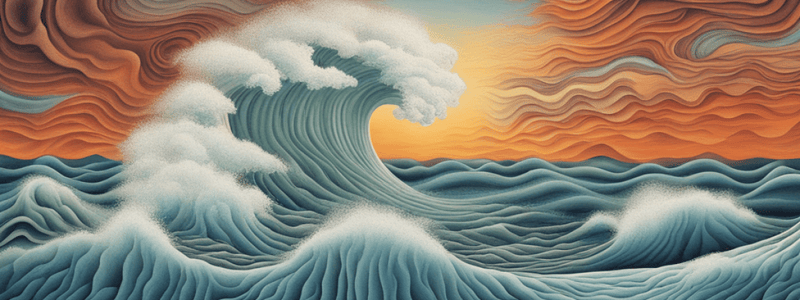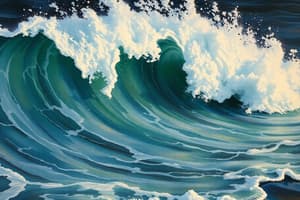Podcast
Questions and Answers
What is the maximum displacement of the disturbance from the equilibrium position called?
What is the maximum displacement of the disturbance from the equilibrium position called?
Amplitude
What is the term for the highest point in a wave?
What is the term for the highest point in a wave?
Crest
What is the term for the lowest point in a wave?
What is the term for the lowest point in a wave?
Trough
What is the term for the length of the wave between two crests or two troughs?
What is the term for the length of the wave between two crests or two troughs?
In which type of wave does the medium oscillate parallel to the direction of the wave pulse?
In which type of wave does the medium oscillate parallel to the direction of the wave pulse?
What is Compression?
What is Compression?
In which type of wave does the medium oscillate perpendicular to the direction of the wave pulse?
In which type of wave does the medium oscillate perpendicular to the direction of the wave pulse?
What's Rarefaction?
What's Rarefaction?
Example of longitudinal wave.
Example of longitudinal wave.
Example of Transverse wave?
Example of Transverse wave?
What's a Period? Symbol? Unit? Formula?
What's a Period? Symbol? Unit? Formula?
What's Sound?
What's Sound?
What's Frequency? Symbol? Unit? Formula?
What's Frequency? Symbol? Unit? Formula?
What's Longitudinal wave pattern?
What's Longitudinal wave pattern?
How do High & Low pressure are caused?
How do High & Low pressure are caused?
Sound waves speed in liquid, gas & s solid (from slowest to fastest)
Sound waves speed in liquid, gas & s solid (from slowest to fastest)
Warner temperatures = sound travel fast
Warner temperatures = sound travel fast
What is an echo?
What is an echo?
Humans hear sound between
Humans hear sound between
What's Pitch?
What's Pitch?
Lower the pitch = Higher the frequency
Lower the pitch = Higher the frequency
When does Doppler effect occur?
When does Doppler effect occur?
As source approaches, waves get __________ (λ ______)
As source approaches, waves get __________ (λ ______)
As source passes by, waves are ____________________ (λ ______________)
As source passes by, waves are ____________________ (λ ______________)
What is the only thing that changes in Doppler effect?
What is the only thing that changes in Doppler effect?
What's Mach Speed?
What's Mach Speed?
What's Sonic Boom?
What's Sonic Boom?
What's mach cone?
What's mach cone?
How do noise cancellation work?
How do noise cancellation work?
Infrasound?
Infrasound?
Ultrasound?
Ultrasound?
Flashcards are hidden until you start studying
Study Notes
Waves and Sound
- The maximum displacement of the disturbance from the equilibrium position is called amplitude.
- The highest point in a wave is called a crest.
- The lowest point in a wave is called a trough.
- The length of the wave between two crests or two troughs is called the wavelength.
Types of Waves
- In a longitudinal wave, the medium oscillates parallel to the direction of the wave pulse.
- In a transverse wave, the medium oscillates perpendicular to the direction of the wave pulse.
- Compression is a region where the particles are close together.
- Rarefaction is a region where the particles are spread apart.
Examples of Waves
- An example of a longitudinal wave is a sound wave in a gas.
- An example of a transverse wave is a light wave.
Properties of Waves
- A period is the time taken by the wave to complete one oscillation.
- The symbol for period is T and its unit is seconds (s).
- The formula for period is T = 1/f, where f is the frequency.
- Sound is a form of mechanical wave that requires a medium to propagate.
Frequency
- Frequency is the number of oscillations or cycles per second.
- The symbol for frequency is f and its unit is Hertz (Hz).
- The formula for frequency is f = 1/T, where T is the period.
Longitudinal Wave Pattern
- In a longitudinal wave, the particles oscillate back and forth along the direction of propagation.
Pressure and Temperature
- High pressure is caused by the particles being compressed, and low pressure is caused by the particles being rarefied.
- In warmer temperatures, sound travels faster.
Echoes and Human Hearing
- An echo is a repeated sound that is reflected back to the listener.
- Humans can hear sound between 20 Hz and 20,000 Hz.
Pitch and Frequency
- Pitch is the perception of the frequency of a sound wave.
- Lower the pitch means higher the frequency.
Doppler Effect
- The Doppler effect occurs when there is relative motion between the source and the observer.
- As the source approaches, waves get shorter (λ decreases).
- As the source passes by, waves are stretched out (λ increases).
- The only thing that changes in the Doppler effect is the wavelength.
Speed of Sound and Mach Speed
- The speed of sound in liquid, gas, and solid (from slowest to fastest) is approximately 343 m/s, 1,482 m/s, and 5,960 m/s respectively.
- Mach speed is the speed of an object as a multiple of the speed of sound (M = v / v_sound).
Sonic Boom and Mach Cone
- A sonic boom is a shockwave produced when an object breaks the sound barrier.
- A mach cone is the cone-shaped shockwave produced by an object traveling at supersonic speeds.
Noise Cancellation and Infrasound/Ultrasound
- Noise cancellation works by producing a sound wave with the same amplitude but opposite phase to cancel out the noise.
- Infrasound is sound with frequencies below 20 Hz, while ultrasound is sound with frequencies above 20,000 Hz.
Studying That Suits You
Use AI to generate personalized quizzes and flashcards to suit your learning preferences.




